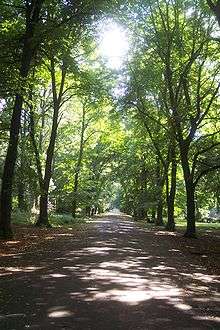Alexandra Park, Manchester
| Alexandra Park | |
|---|---|
 Alexandra Park | |
| Type | Municipal park |
| Location | Whalley Range, Manchester, England |
| Coordinates | 53°27′04″N 2°14′55″W / 53.45111°N 2.24861°WCoordinates: 53°27′04″N 2°14′55″W / 53.45111°N 2.24861°W |
| Area | 60 acres (24 ha) |
| Created | 1868 |
| Operated by | Manchester City Council |
Alexandra Park is a 60-acre (24 ha) park in the Whalley Range district of Manchester, England. It was designed by Alexander Hennell[1] and opened to the public in 1870[2] with the initial purpose to "deter the working men of Manchester from the alehouses during their day off". The lodge and gateways are the work of Alfred Darbyshire. The park was developed by the Manchester Corporation before the area was incorporated into the city, being sited wholly in the then Withington Local Board area; the site was purchased in 1864 by Manchester Corporation from William Egerton, 1st Baron Egerton.[2] The park today lies between Princess Road, Claremont Road, Demesne Road and Alexandra Road South in the M16 postcode district. Work begun in late 2012 led to major changes in the park.
The park was the venue for the great Manchester Women's Suffrage Demonstration of 24 October 1908, and on 11 November 1913, suffragette Kitty Marion planted a bomb that destroyed the park's cactus house.[3]
The park is a well known site of an annual Caribbean music festival.[4] Part of Manchester's Black History Trail crosses the park.[5] In the 1970s, Children's Christian Crusade gatherings were hosted in the park annually.[6]
The park gave its name to the nearby Alexandra Park station, until the station's name changed to Wilbraham Road, on amalgamation in 1923, in order to avoid ticketing confusion.
British aircraft manufacturer Avro assembled aircraft at the Alexandra Park Aerodrome, south of Mauldeth Road West, from 1918, but left for Woodford Aerodrome on its closure in 1924.
The park gives its name to a nearby council estate, developed in the 1960s. The previous Alexandra Park estate was the birthplace, in 1858, of Emmeline Pankhurst.[3]
References
- ↑ Parks for the People: Manchester and Its Parks, 1846–1926. Manchester City Art Galleries. 1987.
- 1 2 "History and design of Alexandra Park". Manchester City Council. Archived from the original on 2011-04-14. Retrieved 2018-08-04.
- 1 2 "Alexandra Park: Present, Past and Future". Pankhurst in the Park. Marple Bridge: Alexandra Arts Ltd. Retrieved 2018-08-04.
- ↑ "Caribbean Festival".
- ↑ "Acts of Achievement". Archived from the original on 24 October 2006. Retrieved 5 November 2005.
- ↑ "Irene Wardle". Lymm Baptist Church. Archived from the original on 2016-10-10. Retrieved 2018-08-04.
External links
| Wikimedia Commons has media related to Alexandra Park, Manchester. |
- "Manchester – Alexandra Park". Archived from the original on 2007-09-22.
- "History and design of Alexandra Park". Manchester City Council. Archived from the original on 2011-04-14.